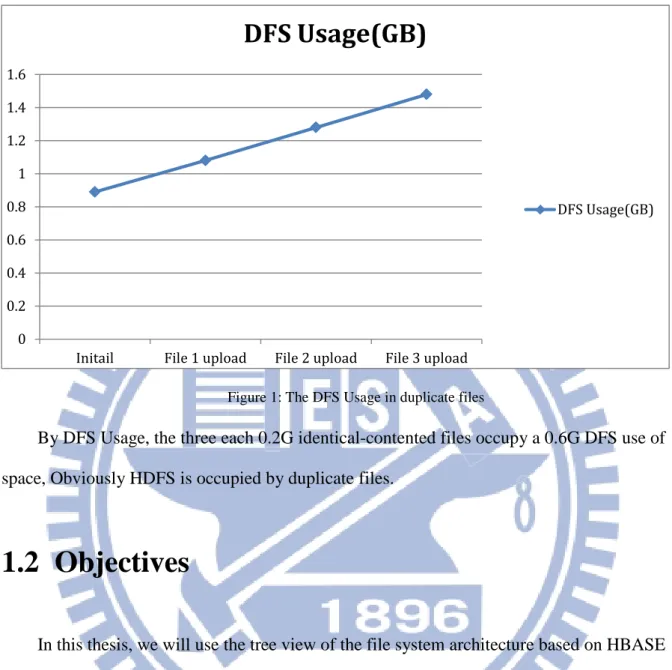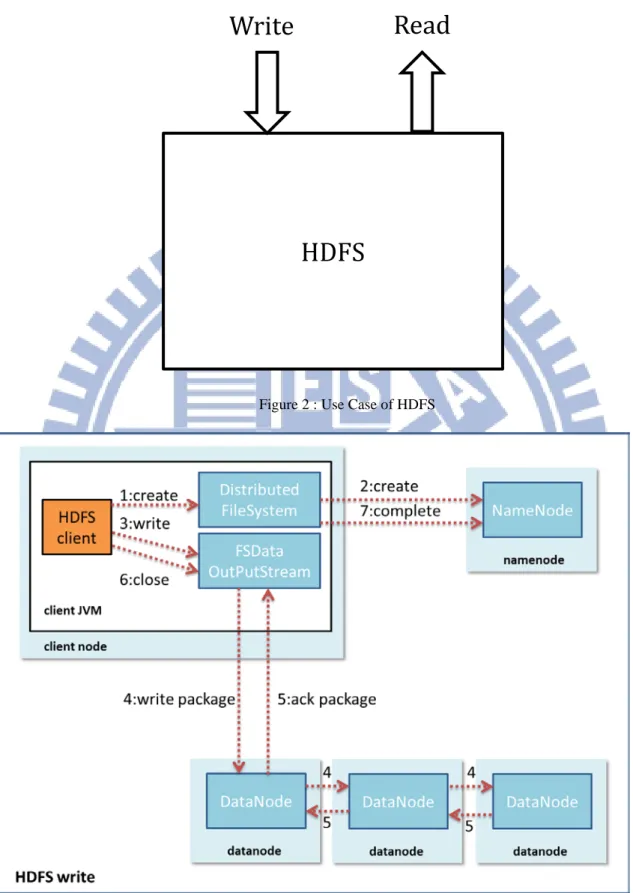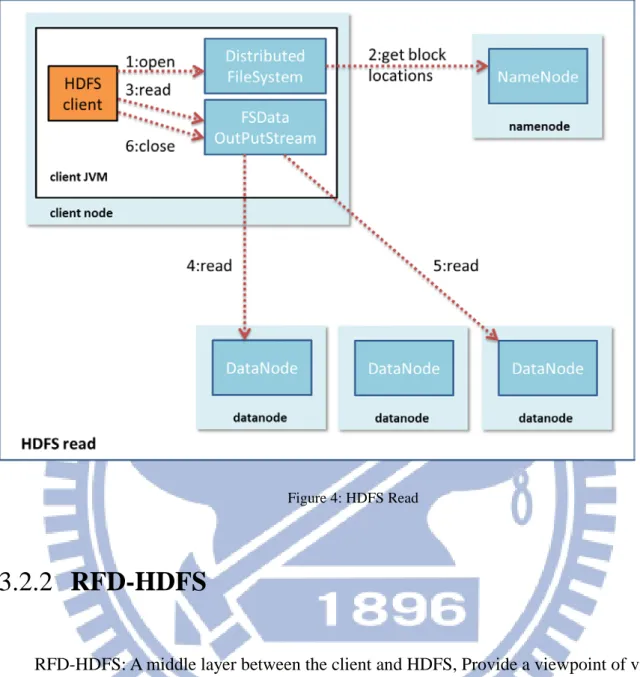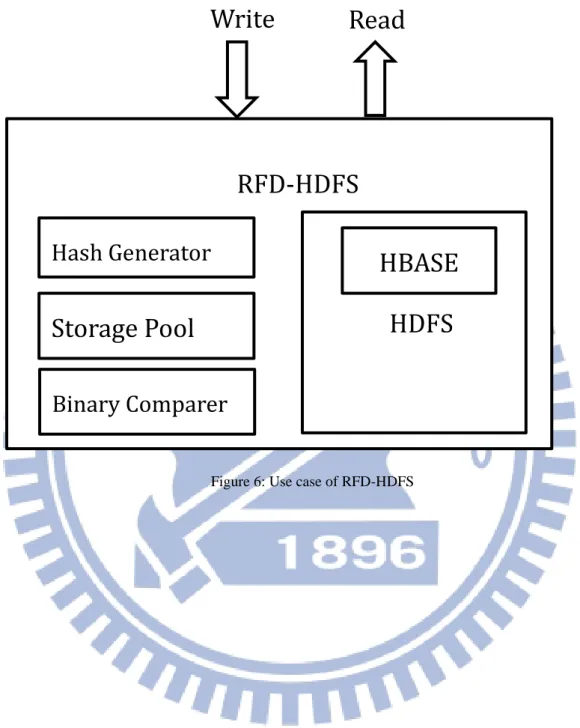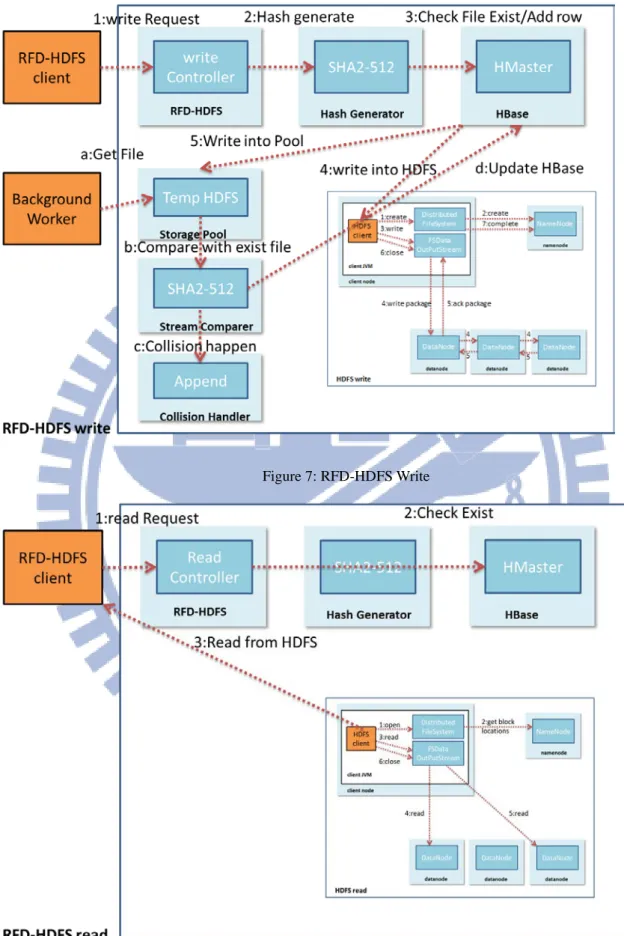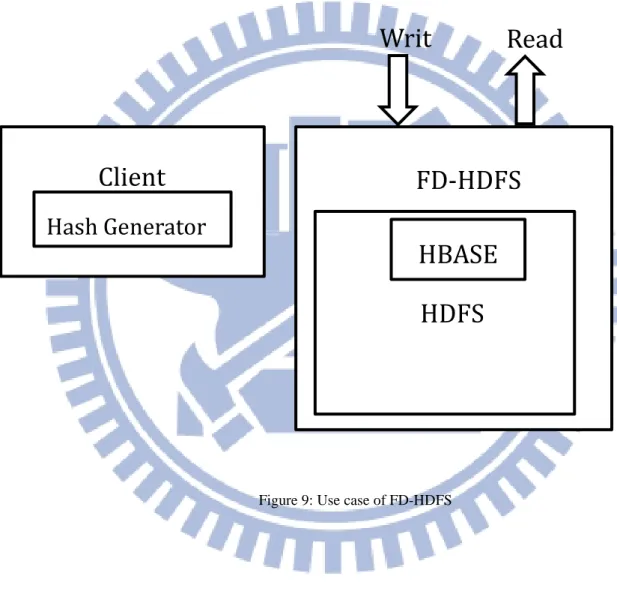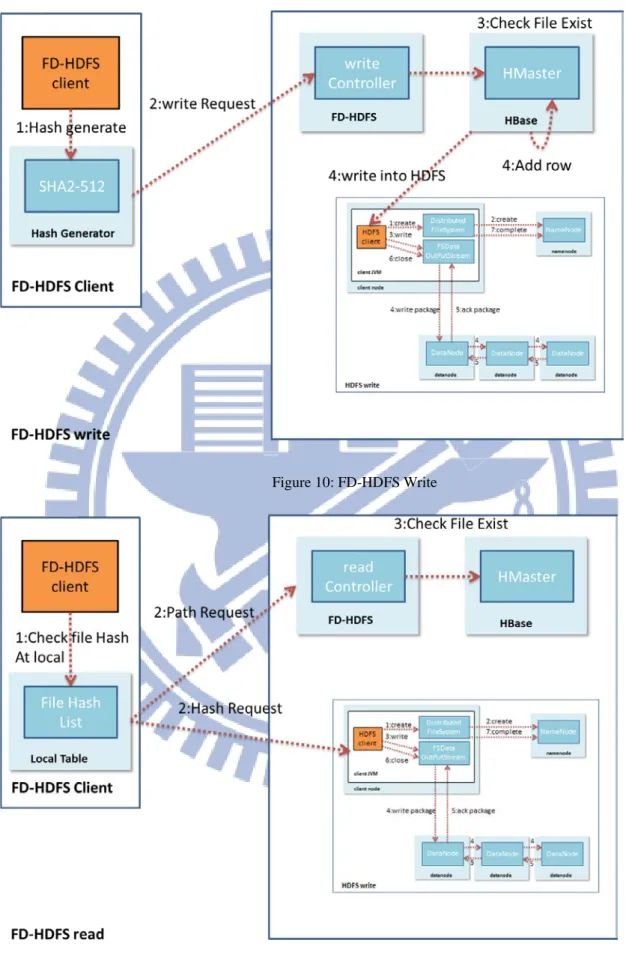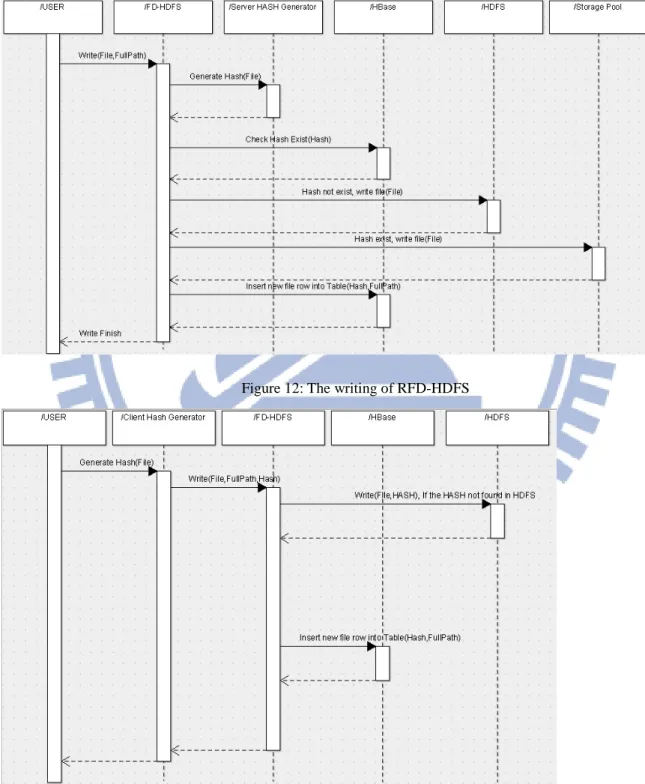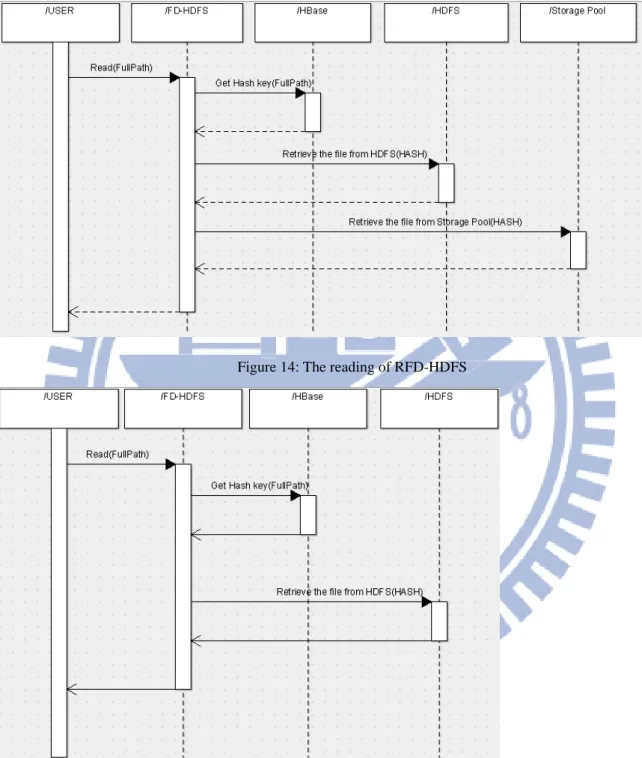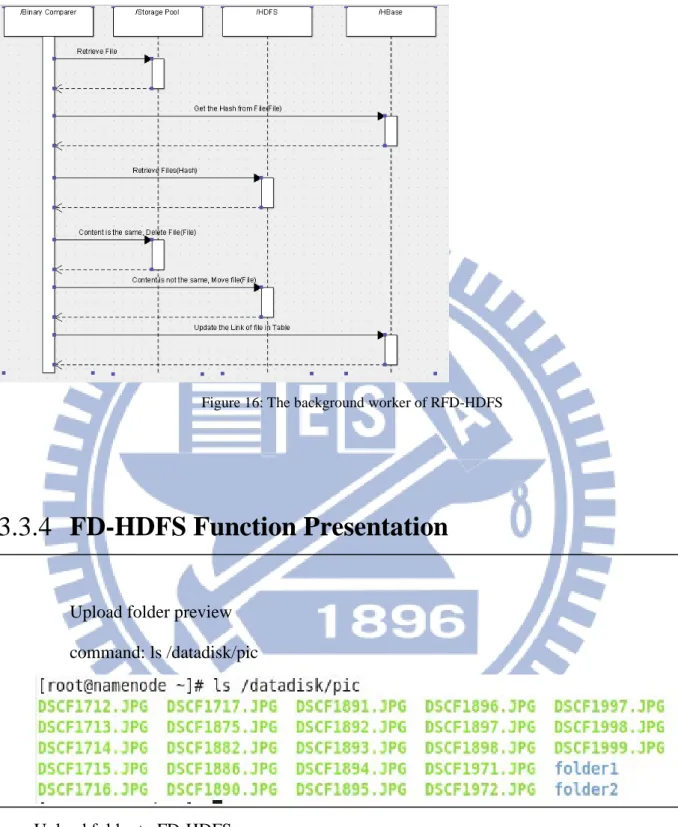國
立
交
通
大
學
資訊學院 資訊學程
碩
士
論
文
雲端儲存的檔案去重複
File Deduplication with Cloud Storage File System
研 究 生:古展易
指導教授:袁賢銘 教授
雲端儲存的檔案去重複
File Deduplication with Cloud Storage File System
研 究 生:古展易
Student:Chan-I Ku
指導教授:袁賢銘
Advisor:Shyan-Ming Yuan
國 立 交 通 大 學
資訊學院 資訊學程
碩 士 論 文
A ThesisSubmitted to College of Computer Science National Chiao Tung University in partial Fulfillment of the Requirements
for the Degree of Master of Science
in
Computer Science Mar 2013
Hsinchu, Taiwan, Republic of China
雲端儲存的檔案去重複
研究生:古展易 指導教授:袁賢銘 教授
國立交通大學 資訊學院 資訊學程碩士班
摘要
Hadoop Distributed File System (HDFS)被運用在解決大量的資料儲存問題,但是並
未提供對重複檔案的處理機制,此研究以 HBASE 架構虛擬中介層檔案系統(Middle layer file system),在 HDFS 中達到 File Deduplication 的功能,依照應用需求的可靠度要求不
同提出兩種架構,一者為不許可有任何錯誤的 RFD-HDFS(Reliable File Deduplicated HDFS),另一者為可容忍極少錯誤的 FD-HDFS (File Deduplicated HDFS)兩種解決方案, 除了空間複雜度上的優勢,也探討比較其帶來之邊際效益。 假設一個內容完全相同的熱門影片被一百萬個用戶上傳到 HDFS,經過 Hadoop replication 成三百萬個檔案來儲存,這是非常浪費磁碟空間的做法,唯有雲端除去重複 才能有效裝載,經此將只占用 3 個檔案空間,也就是達成百分百去除重複檔案的效用。 實驗架構為一個雲端文獻系統,類似 EndNote Cloud 版,模擬研究生將資料與雲端 同步時,與海量數據庫的群聚效應。
關鍵字:HDFS, Data Deduplication, Cloud Computing, Single instance storage.
File Deduplication with Cloud Storage File System
Student:Chan-I Ku Advisor:Dr. Shyan-Ming Yuan
Degree Program of Computer Science
National Chiao Tung University
ABSTRACT
The Hadoop Distributed File System (HDFS) is used to solve the storage problem of
huge data, but does not provide a handling mechanism of duplicate files. In this study, the
middle layer file system in the HBASE virtual architecture is used to do File Deduplicate in
HDFS, with two architectures proposed according to different requires of the applied
requirement reliability, therein one is RFD-HDFS (Reliable File Deduplicated HDFS) which
is not permitted to have any errors and the other is FD-HDFS (File Deduplicated HDFS)
which can tolerate very few errors. In addition to the advantage of the space complexity, the
marginal benefits from it are explored. Assuming a popular video is uploaded to HDFS by one
million users, through the Hadoop replication, they are divided into three million files to store,
that is a practice wasting disk space very much and only by the cloud to remove repeats for
effectively loading. By that, only three file spaces are taken up, namely the 100% utility of
removing duplicate files reaches. The experimental architecture is a cloud based
documentation system, like the version of EndNote Cloud, to simulate the cluster effect of
massive database when the researcher synchronized the data with cloud storage.
Key Words: HDFS, Data Deduplication, Cloud Computing, Single instance storage.
Acknowledgements
首先要感謝袁賢銘教授對我的指導,因為在職的關係,比較沒有機會和分散式實驗 室的小同學交流,所以就不斷勞煩袁教授,教授不但一一解決了我的問題,更提供許多 明確的指導,讓我在研究時快速的釐清問題和方向。 論文口試審查期間王尉任老師,梁凱智博士,林縣城副總提出許多寶貴的意見,讓 我更有效的闡述研究的效益。博士班羅國亨學長積極快速的協助和檢視下,讓我發現研 究的關鍵問題,也感謝洪大均同學在口試期間的幫忙,謝謝我的爸爸媽媽家人朋友同事 同學們給我的支援和幫助。 年輕時因為排斥填鴨式教育和家庭因素未曾用心在學業,出了社會才確信自己的天 賦和能力,程式和軟體設計不但成為我的職業,也成了興趣,碩士學歷對我而言只是在 補償自己過往的遺憾,三十好幾才完成碩士學位並無法挽回過往我錯失的機會,也沒有 值得驕傲的地方,只是實現自己對自己的諾言,人生很多事情都是沒有意義徒勞無功的, 相對的任何事物也都能找出它的價值,經過這些歷練就是我最大的收穫。 IIIList of Contents
Acknowledgements ... III
List of Contents ... IV
List of Figure ... VI
List of Tables ... VII
Introduction ... 1 1 Motivation ... 1 1.1 Objectives ... 3 1.2
Importance and Contribution ... 4 1.3
Outline of the thesis ... 5 1.4
Background And Related Work ... 6 2
Data Deduplication ... 6 2.1
Detection of the Same Data / Similar Data ... 6 2.1.1
Source Deduplication(Client)/ Target Deduplication (Storage Devices) 7 2.1.2
In-line Processing/Post Processing ... 7 2.1.3
Keep old data/new data... 8 2.1.4
Whole File Deduplication vs. Chunk Data Deduplication ... 8 2.1.5 Cloud Storage ... 9 2.1.6 HDFS ... 9 2.2 Hash-SHA2 ... 10 2.3 HBase ... 11 2.4
System Design and Implementation ... 12 3
Overview ... 12 3.1
HDFS ... 12 3.1.1 RFD-HDFS ... 12 3.1.2 FD-HDFS ... 13 3.1.3 Architecture ... 14 3.2 HDFS ... 14 3.2.1 RFD-HDFS ... 16 3.2.2 FD-HDFS ... 19 3.2.3 Algorithm ... 21 3.3 File Writing ... 21 3.3.1 File reading ... 22 3.3.2 Background Worker ... 22 3.3.3 FD-HDFS Function Presentation ... 23 3.3.4 Experiments ... 26 4
Environment, and Setting ... 26 4.1
Experiment 1 ... 27 4.2
Result of Experiment 1 ... 28 4.3
The setting of Experiment 2 ... 30 4.4
Result of Experiment 2 ... 31 4.5
The setting of Experiment 3 ... 33 4.6 Result of Experiment 3 ... 34 4.7 Overhead ... 35 4.8 Multi-Threading(Multi-Users)... 37 4.9 Conclusion ... 38 5 Future Work ... 40 6 Reference ... 41 7 V
List of Figure
Figure 1: The DFS Usage in duplicate files ... 3
Figure 2 : Use Case of HDFS ... 15
Figure 3: HDFS Write... 15
Figure 4: HDFS Read ... 16
Figure 5: The architecture of RFD-HDFS ... 17
Figure 6: Use case of RFD-HDFS ... 17
Figure 7: RFD-HDFS Write ... 18
Figure 8: RFD-HDFS Read ... 18
Figure 9: Use case of FD-HDFS ... 19
Figure 10: FD-HDFS Write ... 20
Figure 11: FD-HDFS Read ... 20
Figure 12: The writing of RFD-HDFS ... 21
Figure 13: The write of FD-HDFS ... 21
Figure 14: The reading of RFD-HDFS ... 22
Figure 15: The reading of FD-HDFS ... 22
Figure 16: The background worker of RFD-HDFS ... 23
Figure 17: File List Preview ... 24
Figure 18: The actual files in HDFS ... 24
Figure 19: The file information in HBASE table ... 25
Figure 20: Two rows in table and a single file stored ... 25
Figure 21: The column Family was delete, but not file in HDFS ... 26
Figure 22: Ex1-DFS usage ... 30
Figure 23: Ex2-DFS usage ... 33
Figure 24: Ex3-DFS usage ... 35
Figure 25: Time usage for Hash and Comparison ... 37
List of Tables
Table 1: Hadoop Nodes ... 26Table 2: The schema and samples of HBase Table ... 27
Table 3: Ex1-User file list ... 27
Table 4: Ex1-DFS usage ... 29
Table 5: Ex2-User file list ... 30
Table 6: Ex2-DFS usage ... 32
Table 7: Ex3-HDFS List ... 33
Table 8: Ex3-DFS usage ... 34
Table 9: Sample files for overhead testing ... 36
Table 10: Result of overhead test ... 36
Table 11: Compare with HDFS ... 38
Introduction
1
As to solving the problems of massive data storage and computing, Google's distributed
Google file system (GFS) at 2003[1], proposed a large number of data processing model
MapReduce at 2004, and a large structured data storage system based on GFS: BigTable at
2006[2], Corresponds to Google, an open-sourced organization- Apache Also continued to
establish incorporating the corresponding GFS's HDFS[3], corresponding BigTable of
HBase[4].
Motivation
1.1
The enterprise has gradually begun to test and apply analytical uses Hadoop as the
storage of large amounts of data and information. However, we found that the growth rate of
the data is much larger than the default value of the 3 time DFS Replication.
The Data Deduplication technology is widely used in business File Server, Database,
NAS (RAID), Backup Devices or lots storage devices, but there is no any implement in
Hadoop.
Hadoop is widely used in the kinds of distributed computing and massive data storage,
through the following simple experiment that, HDFS did not apply any Common Data
Deduplication technology.
When we uploaded three files to the Hadoop Distributed File System (HDFS), which the
file’s name is different but content is the same..
To exclude the deliberately manufactured to ensure reliability(HDFS Replication) of the
data copy of file duplication, three different file names with the same file contents are
generated in a duplicate copy of files. However, the confirmed HDFS does not have any
mechanism to deal with file duplication and it wastes storage space. Here is the Hash sum by
SHA-2[5] from the file apache-solr-4.0.x.tgz, in which we can deduce the three files are
identical, and only their file names are different since the three values of hash sum are the
same.
[root@namenode ~]# sha512sum ~/Downloads/apache-solr-4.0.0.tgz
e37c36f910f922a35877431e44b77f3a035c4ce47bdf78ffc88afcf6c97f42ad6c54cec3f 01b3093f886099688a3e90603f5c879d03cf629621861817973c631
/root/Downloads/apache-solr-4.0.0.tgz
[root@namenode ~]# sha512sum ~/Downloads/apache-solr-4.0.1.tgz
e37c36f910f922a35877431e44b77f3a035c4ce47bdf78ffc88afcf6c97f42ad6c54cec3f 01b3093f886099688a3e90603f5c879d03cf629621861817973c631
/root/Downloads/apache-solr-4.0.1.tgz
[root@namenode ~]# sha512sum ~/Downloads/apache-solr-4.0.2.tgz
e37c36f910f922a35877431e44b77f3a035c4ce47bdf78ffc88afcf6c97f42ad6c54cec3f 01b3093f886099688a3e90603f5c879d03cf629621861817973c631
/root/Downloads/apache-solr-4.0.2.tgz
Copy these 3 files to HDFS by shell command:
Hadoop dfs -copyFromLocal ~/Downloads/apache-solr-4.0.0.tgz test Hadoop dfs -copyFromLocal ~/Downloads/apache-solr-4.0.1.tgz test Hadoop dfs -copyFromLocal ~/Downloads/apache-solr-4.0.2.tgz test
Figure 1: The DFS Usage in duplicate files
By DFS Usage, the three each 0.2G identical-contented files occupy a 0.6G DFS use of
space, Obviously HDFS is occupied by duplicate files.
Objectives
1.2
In this thesis, we will use the tree view of the file system architecture based on HBASE
Table, In the following, we will create the Mapping table between virtual path and Hash sum,
The underlying Key-Value(NoSQL) storage[6] query mechanism has been packaged into the
tree file folder access concept, by which the users can access FD-HDFS by the original tree
folder concept file.
However, due to the presence of Hash, there are possibly the Hash Table balance
problems and birthday attack[7]. MD5 and SHA1 can develop the same HASH file by violent
calculation[8]. However, the SHA2 and SHA3 method of artificially repeating the HASH
value are still not found but the Collision cannot be avoided. Therefore, two architectures are
proposed in accordance with the reliability of application requirements: One is the
0 0.2 0.4 0.6 0.8 1 1.2 1.4 1.6
Initail File 1 upload File 2 upload File 3 upload
DFS Usage(GB)
DFS Usage(GB)
RFD-HDFS (Reliable File Deduplicated HDFS) which does not allow any error. The other is
FD-HDFS (File Deduplicated HDFS) which can tolerate very few errors. In addition to reduce
of space complexity, the marginal benefits will be explored and compared.
In the normal distribution of user file holdings; there is inevitably the intersection in the
files held by different users and even multiple intersections. In a variety of environments, the
probability of different intersections is higher for videos, music, documents, and e-books, that
user repeat cross-holdings, and the unique probability for the machine-generated files is
generally lower.
For example, if time is frozen, there is limited number of video files all over the world to
be load by Hadoop, such as Google YouTube using GFS. As for the technical documents,
reports, patents, journals, research reports, test reports, assessment data, procurement
reference documents, pictures and other electronic files are centralized and provide query
interface. Or, the cloud based EndNote can be constructed. When the graduate student
synchronizes the paper to the cloud terminal, through the Deduplication technology, massive
data storage becomes possible and efficient that the MapReduce computing capability can be
used more to construct the data document Meta-Data so as to achieve the efficacy of quick
searches and optimize Data-Mining. The premise of these benefits, however, is framed in the
effectively-used storage space system, which is the purpose to achieve in this study.
Importance and Contribution
1.3
Although the architectures in the traditional hard disk array has the higher characteristics
of reducing data and the use of cutting and version stack, these algorithms cannot be applied
to the Hadoop since Hadoop has its unique cut demand. The traditional hard disk array cannot
be elastic expanded and has no clustering effect of mass data, therefore, this framework
maintains the Replication that HDFS maintains the reliability and there is no side effects
sacrificing reliability in exchange for space-saving and no the Over Head brought by
complicated algorithm.
Assuming a popular video is uploaded to HDFS by one million users and stored by
cutting into three million files through Hadoop replication, it is a practice very wasting disk
space. Only after the cloud removes duplicate files can all files be effectively loaded. Through
this system, only three file spaces are occupied, namely reaching the utility of completely
removing duplicate files.
In the FD-HDFS architecture, the Client terminal can achieve the effect of Source
Deduplication by HASH sum, so as to save upload time and bandwidth. The RFD-HDFS can
completely ensure data accuracy and achieve the benefits of de-duplication.
Outline of the thesis
1.4
Chapter 1 has presented a brief introduction to the concepts of uncertainty, and the
importance of uncertainty analysis in the context of transport-transformation models. It has
also discussed the steps involved in a systematic uncertainty analysis, and the associated
limitations. Additionally, Chapter 1 summarizes the objectives and presents a brief overview
of this thesis.
Chapter 2 presents the relevant background information in the following order: Data
Deduplication, HDFS, Hash-SHA2, Hash Collision and HBase.
Chapter 3 shows the original HDFS model architecture, the RFD-HDFS model
architecture, and the FD-HDFS model architecture.
Chapter 4, the experiment environment set with: 1. 20 users upload the folders when
there is no data in the cloud. 2. 20 users upload data when the database has a certain amount
of data. 3. The crossover experiment, in which the same user samples 10-100% of the
precursor in the database.
Chapter 5 presents the conclusions of this thesis, and recommendations for future work.
This is followed by bibliography.
Chapter 6 future works of the thesis.
Background And Related Work
2
Data Deduplication
2.1
The hard disk drive, Disk RAID, NAS, Type storage or Storage Server…, we can do broadly
the data deduplication job to do the following classification.
Detection of the Same Data / Similar Data
2.1.1
The same data detection mainly includes two levels, the same File and the same Data
Block. In the technology of the whole file detection[9], the Data Mining is conducted through
the hash technology[5]. In the same Data Block detection, the fingerprint is checked through
the fixed-sized partition or the check and deletion of duplicate data are conducted through the
detection technology of content-defined chunking and the sliding block technology.
The similar data detection uses similar data characteristics, through the shingle
technology and the bloom filter technology, the duplicate data which the same data detection
cannot detect is found out. For similar data, the delta technology is used to encode, minimize,
and compress similar data, further reducing the storage space and the network bandwidth
usage.
Source Deduplication(Client)/ Target Deduplication
2.1.2
(Storage Devices)
In typical storage applications such as backup and replication, data is moved from
Source to the target storage devices through the network. Therefore, the source end is the
front-end application Host or the Backup server to produce the raw data. The target end is the
ultimate storage equipment, such as VTL or disk arrays.
But at the front end where the data deletion calculus is conducted, the deletion computing is
first conducted before the data is sent to the network. Therefore, it has the advantage of saving
the network bandwidth and the upload time, but the deletion computing will occupy the
computing resources in the front end of the host.As for the advantages and disadvantages of
Target Deduplication, although the network bandwidth cannot be saved, the resources of the
front-end host will not be consumed.
In-line Processing/Post Processing
2.1.3
Online In-line processing means the deletion computing is synchronously executed when
the data is performed with backup, copy or writing to the disk. In other words, when the data
is copied for the preparation of sending it to the Destination through the network, or the
back-end storage device receives the Source data via the Internet and prepare to write to the
disk, the De-Dupe system will conduct data content comparison and deletion computing at the
same time. Processing after writing in means after the data is written to the disk, it is started
by instruction, or the deletion computing is conducted for the data stored on the disc in the
customized scheduled startup De-Dupe system.
The advantages and disadvantages of online In-line processing and processing after
writing are just at the opposite. Since data comparison and deletion computing quite consume
processor resources, if the online real-time processing architecture is adopted, the system
performance will be clearly temporized so that the backup speed will be delayed. But
relatively, since the deletion computing has been conducted before the data is written to the
disc, it occupies less space. In comparison, although the system performance will not be
affected in processing after writing in, we can choose off-peak hours to start the De-Dupe. But
when the data is written to the disc, the original form without deletion is maintained, so that
the same storage space is occupied like the front-end and the reduction effect is shown after
the De-Dupe is started up. Therefore, the De-dupe products in processing after writing in; the
users must prepare a larger temporary storage space.
Keep old data/new data
2.1.4
De-Dupe technology will delete duplicate data, and there are two deletion ways:
One is to retain old data. When new information is determined to be the repeat of the old
data, the system will remove new data and create an index pointing to the old data. The other
is to retain new information. When the new data is determined as the repeat with the old data, the
old data will be deleted and the index will be pointed to the new location.
Whole File Deduplication / Chunk Data
2.1.5
Deduplication
DUTCH T. MEYER[10] find that whole-file deduplication together with sparseness is a
highly efficient means of lowering storage consumption, even in a backup scenario. It
approaches the effectiveness of conventional deduplication at a much lower cost in
performance and complexity. The environment we studied, despite being homogeneous,
shows a large diversity in file systems and file sizes. These challenges, the increase in
unstructured files and an ever-deepening and more populated namespace pose significant
challenge for future file system designs. However, at least one problem – that of file
fragmentation, appears to be solved, provided that a machine has periods of inactivity in
which defragmentation can be run.
There should be more trouble in reliability and compatibility at the peer project of
Hadoop: Nutch, Hive, Pig …
Cloud Storage
2.1.6
These above-mentioned technologies are widely used in the storage devices of enterprise
File Server, Database, NAS (RAID), and Backup Devices. However, there is no related
implementation in Hadoop since HDFS has its special block mode and network Topology[11]
demand to ensure the reliability of the copy. So, the similar data detection is not the
conditions to remove duplicate files. In too much emphasizing on the space use of algorithm,
the questions of reliability and the hard error reversion will be relatively occur and the
overhead will be produced in effect. Therefore, here the same data detection is used to apply
the detection technology for the same file data in HDFS, and the File Level Deduplication is
conducted in the methods of HASH and Stream Compare.
HDFS
2.2
The Hadoop Distributed File System (HDFS) is a distributed file system designed to run
on commodity hardware[3], and be used to replace the high-priced server; HDFS is highly
Fault-tolerant and designed to be deployed on low-cost hardware. Used to replace the
high-priced Disk Raid, HDFS provides application data with high throughput access, to
replace the hardware routing shunt dispersed bandwidth and server load. There are automatic
propagation and flexibility to increase or decrease for mass storage.
MapReduce may analyze the data and create the meta-data of file for file searching, and
HDFS is base storage for MapReduce.
HDFS File access can be achieved through the native Java API, the Thrift API to
generate a client in the language of the users' choosing (C++, Java, Python, PHP, Ruby, Erlang,
Perl, Haskell, C#, Cocoa, Smalltalk, and OCaml), the command-line interface, or browsed
through the HDFS-UI webapp over HTTP.
Hash-SHA2
2.3
In cryptography, SHA-2 is a set of cryptographic hash functions (SHA-224, SHA-256, SHA-384, SHA-512) designed by the National Security Agency (NSA) and published in 2001 by the NIST as a U.S. Federal
Information Processing Standard[5]. SHA stands for Secure Hash Algorithm. SHA-2 includes a significant number of changes from its predecessor, SHA-1. SHA-2 consists of a set of four hash functions with digests that are 224, 256, 384 or 512 bits.
In 2005, security flaws were identified in SHA-1, namely that a mathematical weakness might exist, indicating that a stronger hash function would be desirable. Although SHA-2 bears some similarity to the SHA-1 algorithm, these attacks have not been successfully extended to SHA-2.
In computer science, a collision or clash is a situation that occurs when two distinct
pieces of data have the same hash value, checksum, fingerprint, or cryptographic digest.[12]
Collisions are unavoidable whenever members of a very large set (such as all possible
person names, or if this was sent to other people, or all possible computer files) are mapped to
a relatively short bit string. This is merely an instance of the pigeonhole principle.
The impact of collisions depends on the application. When hash functions and
fingerprints are used to identify similar data, such as homologous DNA sequences or similar
audio files, the functions are designed so as to maximize the probability of collision between
distinct but similar data. Checksums, on the other hand, are designed to minimize the
probability of collisions between similar inputs, without regard for collisions between very
different inputs
How big is SHA2-512? How often does the hash collision happen?
Total Bits of 𝑆𝑆𝑆𝑆𝑆𝑆512 = 2512 ≈ 10155𝐵𝐵𝐵𝐵𝐵𝐵
If we store 1 Million files into hash table, the chance of hash collision for next store operation
should be 106/10155=10−149
HBase
2.4
Apache HBase: random, real-time read/write access to your Big Data[4]. This project's
goal is the hosting of very large tables -- billions of rows X millions of columns -- atop
clusters of commodity hardware. Apache HBase is an open-source, distributed, versioned,
column-oriented store modeled after Google's Bigtable: A Distributed Storage System for
Structured Data by Chang et al. Just as Bigtable leverages the distributed data storage
provided by the Google File System, Apache HBase provides Bigtable-like capabilities on top
of Hadoop and HDFS.
HBase uses a data model very similar to that of Bigtable. Users store data rows in
labeled tables. A data row has a sortable key and an arbitrary number of columns. The table is
stored sparsely, so that rows in the same table can have crazily-varying columns, if the user
likes. At its core, HBase/BigTable is a map. Depending on your programming language
background, you may be more familiar with the terms associative array (PHP), dictionary
(Python), Hash (Ruby), or Object (JavaScript).
A table's column families are specified when the table is created, and are difficult or
impossible to modify later. It can also be expensive to add new column families, so it's a good
idea to specify all the ones you'll need up front.
Fortunately, a column family may have any number of columns, denoted by a column
"qualifier" or "label".
All data is versioned either using an integer timestamp (seconds since the epoch), or
another integer of your choice. The client may specify the timestamp when inserting data.
System Design and Implementation
3
Overview
3.1
HDFS
3.1.1
In uploading files directly to HDFS, it is the original architecture of HDFS[13]. The
Hadoop API provides a Shell command and Java API as a file management interface.
The version of Hadoop is 1.03; the version of HBase is 0.94.3.
RFD-HDFS
3.1.2
In the applications which require precise calculation without any errors, such as financial
computing, errors are definitely not allowed in the computing system. Due to the SHA Hash
Collision, the conflict probability still cannot be ignored even though it is very low
(depending on the algorithm). In binary comparison, in order to ensure data accuracy, time
and resources will be wasted for the file comparison. Therefore, the binary comparison circuit
or the MapReduce cluster computing capacity[14] can be used to speed up file comparison. At
the same time, the Post Processing method is adopted to reduce user’s time for waiting- files
are first uploaded to the temporary storage pool, waiting for the background worker for the
implementation of file comparison. In this study, the Stream Comparison is used to partially
retrieve data fragments to conduct Binary Compare in the sequential serial method.
Three phases are divided to determine whether the files are the same:
1. If the Hash value exists.
2. If the File Sizes are the same.
3. Gradually and sequentially executing Stream Comparison.
Once any difference is found in the comparison work in each phase, the comparison will
be immediately stopped so as not to consume computing power and occupy resources. For the
Collision policy of the Duplicate files, if the SHA value of the file is the same, the file size is
the same. At the time, it is necessary to first put the files in the Storage Pool, waiting for the
Background Process to conduct the Stream comparison to decide whether the hash collision
policy is started. Therein, the used file path is appended after the file name as a handling
strategy of hash collision.
FD-HDFS
3.1.3
In the application where little errors can be tolerated, such as Web information extraction
(for search engine use) and vocabulary and semantic analysis, the repeat Collision less likely
occurs and the judgment result application will not be affected. The HASHs with the same
fingerprints are regarded as the duplicate files. Thus, the effect of Source Deduplication can
be reached, the effect of reducing the network bandwidth and saving upload time is achieved,
and even the burden of NameNode and HBase can be reduced.
For example, web crawler software Nutch[15] daily needs to capture page files to HDFS.
In accordance with the comparison of the HASH value and the HBASE database, it can
quickly learn if the website content changes so that the time for Binary Compare can be saved
and the target can be retrieved, such as directly generating the SHA value from the source end.
If the source SHA does not change, the time of uploading Full Content will be saved further.
If Hash generates program to implant the Host from source, the loading of NameNode and
HMaster can be eased so that a crawl for a website becomes the crawl for new added and
changed files, which saves not only upload time and the bandwidth but server side Loading.
Architecture
3.2
HDFS
3.2.1
In the use case of HDFS, users may access file by the Hadoop shell command or Hadoop
API.
HDFS: Hadoop Distributed file system.
Write: The API of file write into HDFS (Upload).
Read: The API of file read from HDFS (Download).
Figure 2 : Use Case of HDFS
Figure 3: HDFS Write
HDFS
Write
Read
Figure 4: HDFS Read
RFD-HDFS
3.2.2
RFD-HDFS: A middle layer between the client and HDFS, Provide a viewpoint of visual
HDFS, if client try to access the file over RFD-HDFS, the files Deduplication is enabled.
HBase: The HBase table records the mapping between Hash key and Full Path of file.
Hash Generator: In the hash key generator function for file, it could be present by SHA2,
SHA3…
Binary comparer: The comparer could be a circuit of hardware or MapReduce function
of Hadoop.
Storage Pool: A Temporary file pool for post processing, the binary comparer will load
the file and do comparisons in background. All files store into pool will be log for tracking,
and file could be roll back for fail over.
Figure 6: Use case of RFD-HDFS
Figure 5: The architecture of RFD-HDFS
HDFS
HBASE
RFD-HDFS
Binary Comparer
Write
Read
Hash Generator
Storage Pool
17Figure 7: RFD-HDFS Write
Figure 8: RFD-HDFS Read 18
FD-HDFS
3.2.3
FD-HDFS: If the Error Torrance is acceptable, we can ignore the collision of Hash; let’s
move the Hash generator to the side of client. And the binary comparer and storage pool is
removed.
Figure 9: Use case of FD-HDFS
HDFS
HBASE
FD-HDFS
Writ
Read
Client
Hash Generator
Client
19Figure 10: FD-HDFS Write
Figure 11: FD-HDFS Read 20
Algorithm
3.3
File Writing
3.3.1
Figure 12: The writing of RFD-HDFS
Figure 13: The write of FD-HDFS 21
File reading
3.3.2
Figure 14: The reading of RFD-HDFS
Figure 15: The reading of FD-HDFS
Background Worker
3.3.3
Figure 16: The background worker of RFD-HDFS
FD-HDFS Function Presentation
3.3.4
Upload folder preview
command: ls /datadisk/pic
Upload folder to FD-HDFS
command: java -jar FD.jar writefolder /datadisk/pic pic
List Files in FD-HDFS
command: java -jar FD.jar ls pic
Figure 17: File List Preview
The actual files in HDFS
Figure 18: The actual files in HDFS
The file information in HBASE table
Figure 19: The file information in HBASE table
Let’s truncate table and clear hdfs
Upload 2 files which the content of files both the same
command: java -jar FD.jar write /datadisk/pic/DSCF1715.JPG pic/file1.JPG
command: java -jar FD.jar write /datadisk/pic/DSCF1715.JPG pic/file2.JPG
We’ll found two rows in table of hbase and a single file stored in HDFS.
Figure 20: Two rows in table and a single file stored
Read file from FD-HDFS
command: java -jar FD.jar read pic/file1.JPG /datadisk/pic/file1.JPG
Delete file1 from FD-HDFS
command: java -jar FD.jar delete pic/file1.JPG
Figure 21: The column Family was delete, but not file in HDFS
Delete file2 from FD-HDFS
command: java -jar FD.jar delete pic/file2.JPG
If the setting of delete option is true, the file will be removing from HDFS, and nothing exists
in table and hdfs.
But the default value is false, the file is no use right now, but it may be uploading by the other
user in the future.
Experiments
4
Try to build up an EndNote[16] storage over cloud, import the collection of papers from
20 student, and simulate the user upload all the files to cloud.
The setting of Hadoop dfs.replication is 3.
Environment, and Setting
4.1
Table 1: Hadoop Nodes
Host Name OS IP HBase Process
NameNode CentOS 6.3 192.168.74.100 HMaster FD.jar& RFD.jar
DataNode1 CentOS 6.3 192.168.74.101 HRegion
DataNode2 CentOS 6.3 192.168.74.102 HRegion
DataNode3 CentOS 6.3 192.168.74.103 HRegion
Table 2: The schema and samples of HBase Table
Row Key Time Stamp FullPath File Attributes
Permissions Size Update Time
File HASH T1 Test/apache-solr-4.0.0.tgz -rwxr-xr-x 200M T11 File HASH T2 Test/apache-solr-4.0.1.tgz -rwxr-xr-x 200M T12 File HASH T3 Test/apache-solr-4.0.2.tgz -rwxr-xr-x 200M T13
Experiment 1
4.2
The experiment 1, FD-HDFS is empty, there is a little duplicated file between user and
user, and no duplicate between user and FD-HDFS before user upload.
The flow of experiment 1:
a. Truncate HBase table and delete all files from FD-HDFS.
b. Upload user# files.
c. Write down the space usage.
Repeat b and c.
Table 3: Ex1-User file list
File Size(MB) File Count Duplicate (%) File Size*3 27
USER01 7.2 18 0 21.6 USER02 14.1 25 0 42.3 USER03 6.3 30 0 18.9 USER04 8.3 22 0 24.9 USER05 68.9 24 0.29 206.7 USER06 10 22 0 30 USER07 23.2 38 10.3 69.6 USER08 101.6 184 2.2 304.8 USER09 70.3 80 2.5 210.9 USER10 15.6 33 23.7 46.8 USER11 41.9 62 3.8 125.7 USER12 94.3 164 6.3 282.9 USER13 61.1 108 7.6 183.3 USER14 25,3 38 11.8 75.9 USER15 34.7 62 8.9 104.1 USER16 24.4 42 2 73.2 USER17 3.6 15 0 10.8 USER18 20.1 31 8.4 60.3 USER19 12.1 20 28 36.3 USER20 3.7 18 13.5 11.1
Total 646.7 1036 2% per user 1904.1
Result of Experiment 1
4.3
Table 4: Ex1-DFS usage HDFS(MB) FD-HDFS(MB) RFD-HDFS(MB) Initial 2.25 9.05 8 USER01 24 24.59 24.12 USER02 66.63 67.22 66.75 USER03 85.66 86.25 85.78 USER04 110.9 111.5 111.45 USER05 319.22 319.22 318.75 USER06 351.27 349.46 348.99 USER07 421.29 414.15 413.68 USER08 728.57 714.81 714.34 USER09 941.12 921.94 921.47 USER10 988.21 958.16 957.69 USER11 1090 1060 1060 USER12 1370 1320 1320 USER13 1550 1490 1490 USER14 1690 1550 1550 USER15 1730 1650 1650 USER16 1800 1720 1720 USER17 1810 1730 1730 USER18 1870 1790 1790 USER19 1910 1810 1810 USER20 1920 1820 1820 29
Figure 22: Ex1-DFS usage
The setting of Experiment 2
4.4
Let’s fill all files which download from ACM and JSTOR. (About 20,000 Files)
Simulating the most of files was uploaded to HDFS.
The flow of experiment 2:
a. Truncate HBase table and delete all files from FD-HDFS.
b. Upload user# files.
c. Write down the space usage.
Repeat b to c.
Table 5: Ex2-User file list
File
Size(MB)
File Count Duplicate
(%) File Size*3 0 500 1000 1500 2000 2500
DFS Usage, HDFS Empty
HDFS FD-HDFS RFD-HDFS 30USER01 7.2 18 66 21.6 USER02 14.1 25 76 42.3 USER03 6.3 30 30 18.9 USER04 8.3 22 59 24.9 USER05 68.9 24 58 206.7 USER06 10 22 13 30 USER07 23.2 38 42 69.6 USER08 101.6 144 41 304.8 USER09 70.3 120 50 210.9 USER10 15.6 33 57 46.8 USER11 41.9 62 38 125.7 USER12 94.3 164 17 282.9 USER13 61.1 108 26 183.3 USER14 25,3 38 73 75.9 USER15 34.7 62 74 104.1 USER16 24.4 42 83 73.2 USER17 3.6 15 33 10.8 USER18 20.1 31 61 60.3 USER19 12.1 20 75 36.3 USER20 3.7 18 72 11.1 Total 646.7 1036 40.9 1904.1
Result of Experiment 2
4.5
31Table 6: Ex2-DFS usage HDFS(GB) FD-HDFS(GB) RFD-HDFS( GB) Initial 44.81 44.82 44.82 USER01 44.83 44.83 44.83 USER02 44.87 44.83 44.83 USER03 44.89 44.84 44.84 USER04 44.91 44.84 44.84 USER05 45.12 44.86 44.86 USER06 45.15 44.89 44.89 USER07 45.21 44.93 44.93 USER08 45.51 45.10 45.10 USER09 45.72 45.19 45.19 USER10 45.77 45.21 45.21 USER11 45.88 45.24 45.24 USER12 46.02 45.47 45.47 USER13 46.35 45.62 45.62 USER14 46.43 45.65 45.65 USER15 46.53 45.66 45.66 USER16 46.60 45.67 45.67 USER17 46.61 45.68 45.68 USER18 46.67 45.70 45.70 USER19 46.72 45.71 45.71 USER20 46.73 45.71 45.71 32
Figure 23: Ex2-DFS usage
The setting of Experiment 3
4.6
Let’s simulate the FD-HDFS import all files from 10% to 100%, and User08 uploads the
same 184 files to each FD-HDFS.
The flow of experiment 3:
a. Truncate HBase table and delete all files from FD-HDFS.
b. Upload files to FD-HDFS, file duplicate is 10%~100%.
c. Upload user8 files.
d. Write down the increase of space usage.
d. Repeat b to d.
Table 7: Ex3-HDFS List
Duplicat File Size(MB) File Count File
43.5 44 44.5 45 45.5 46 46.5 47
DFS Usage, HDFS Imported
HDFS FD-HDFS RFD-HDFS 33e (%) Size*3 HDFS00% 0 101.6 184 304.8 HDFS10% 10 101.6 184 304.8 HDFS20% 20 101.6 184 304.8 HDFS30% 30 101.6 184 304.8 HDFS40% 40 101.6 184 304.8 HDFS50% 50 101.6 184 304.8 HDFS60% 60 101.6 184 304.8 HDFS70% 70 101.6 184 304.8 HDFS80% 80 101.6 184 304.8 HDFS90% 90 101.6 184 304.8 HDFS100% 100 101.6 184 304.8
Result of Experiment 3
4.7
Table 8: Ex3-DFS usage
HDFS FD-HDFS RFD-HDFS HDFS00% 304.81 299.61 299.61 HDFS10% 304.82 269.34 269.34 HDFS20% 304.77 241.18 241.18 HDFS30% 304.80 210.81 210.81 HDFS40% 304.81 174.03 174.03 HDFS50% 304.81 151.99 151.99 34
HDFS60% 304.78 121.7 121.7
HDFS70% 304.80 91.46 91.46
HDFS80% 304.82 62.14 62.14
HDFS90% 304.80 32.20 32.20
HDFS100% 304.81 0 0
Figure 24: Ex3-DFS usage
Overhead
4.8
The experiment of overhead was running at VMware WorkStation 9, the hard disk drive
is 1T 5400rpm.
6 file will be upload to FD-HDFS, let’s record the time span in log file.
The flow of experiment overhead:
a. Truncate HBase table and delete all files from FD-HDFS.
b. Upload file #. 0 50 100 150 200 250 300 350
DFS Usage
HDFS FD-HDFS RFD-HDFS 35c. Write down the log for time usage.
Repeat b to d.
Table 9: Sample files for overhead testing
File Size(MB) File0 131 File1 1001 File2 2051 File3 3024 File4 3992 File5 4989
Table 10: Result of overhead test
FD-HDFS(RFD-HDFS Post process) RFD-HDFS(In-Process) HDFS Write File0 10.4 29.5 9 File1 270.6 434.6 260 File2 548.3 835 520 File3 881 1318 774 File4 1073 1724 1020 File5 1383 2156 1305 36
Figure 25: Time usage for Hash and Comparison
Multi-Threading(Multi-Users)
4.9
20 User upload all file to cloud at the same time. The system have no issue about
Multi-Threading.
The flow of experiment Multi-Users:
a. Truncate HBase table and delete all files from FD-HDFS.
b. Upload all files from 20 users one by one.
c. Truncate HBase table and delete all files from FD-HDFS.
d. Upload all files from 20 users at the same time.
File Size(MB) Log
Single thread 2 minutes 28 sec 04:42:59-985-HASH start
04:45:27-989-WRITEFOLDER End
Multi thread 2 minutes 9 sec 04:31:37-985-HASH start
0 500 1000 1500 2000 2500
File0 File1 File2 File3 File4 File5
Time Usage (sec)
FD-HDFS(RFD-HDFS Post process) RFD-HDFS(In-Process) HDFS
04:33:46-195-WRITEFOLDER End
We’ll see the multi-threading is a little faster than the single one. But the user count is much
bigger than 20, the effective of nodes cluster should not a few second of process time.
Conclusion
5
Table 11: Compare with HDFS
HDFS RFD-HDFS FD-HDFS
File
Deduplication
No Yes Yes
File Reliability O O X(SHA2-512=2512)
The Loading of
comparison
No Hash generate, Stream
compare
Hash generate
The Cost of
Upload time
and Bandwidth
Full Full The duplicated file
upload/download time and
bandwidth are almost zero
Loading of
NameNode and
HMaster
Normal Normal May be reduced
Same Data /
Similar Data
Not support. Same Data Same Data
Source
Dedup/Target
Not support. Target Dedup Source Dedup
Dedup
In Line
Process/Post
Process
Not support. Post Process In Line Process
Keep old
data/new data
Not support. Keep old data Keep old data
SHA1 needs 263 to find the file of different content but equal Hash Sum[8]. It is obvious that the SHA2-512 collision probability is very low, so the experimental results of RFD-HDFS
and FD-HDFS are identical. That is, although the Hash Collision Policy has been concluded,
there is no opportunity to use. The chance of the hash collision should be really small, but
how about the Nuclear Science and financial application? That’s the reason about the model
of RFD-HDFS, which will be individually listed since many systems still cannot afford
one-astronomical number error, many systems have the requirements of saving transmission
time and the bandwidth, and the both have suitable occasions and applications.
From first experimental results, we can observe that the probability of holding duplicate
files between User and User is not high.
The reason why the repeat exists is because in the experiment, the students electing the
same course participated and needed to report the paper report, that the opportunity
interactively holding the same file. But as long as the clouds do not have any information, the
rate of repetition is low.
In the second experiment, we had simulated the cloud HD-HDFS operation for a certain
time and have housed many papers. Many documents already exist in FD-HDFS, under which
we can observe the space complexity decreased.
In the third experiment, the same user uploaded the same paper at different points of time.
We can find that the FD-HDFS system housed more papers have less space occupancy rate. In
ideal, when storage references reach one hundred percent, then all new existing files will no
longer consume space.
In conclusion, a centralized cloud system can gradually lead to the increase of file
repetition when the users upload data. Through file de-duplication, the storage space required
can be greatly reduced.
Through this system, incorporating some type of file population becomes possible. What
is needed is only constant space.
RFD-HDFS system suitable for use in commercial information, nuclear engineering, if
the application cannot allow any error; FD-HDFS could implement at most kind of files, if a
small error is acceptable.
Future Work
6
The MapReduce is useful to determine how to split the file to data blocks (Chunk), For
example: a Longest Common Subsequence (LCS) for determine the diff of the file content,
but if the file was split, there should be data fragmentation issue. DUTCH T. MEYER[10]
find that whole-file deduplication together with sparseness is a highly efficient means of
lowering storage consumption, even in a backup scenario. It approaches the effectiveness of
conventional deduplication at a much lower cost in performance and complexity.
Hadoop provide compressed stream write in, but it’s optional and should be handle by
programmer or user. If the middle layer file system exists, the compress function could apply
to each file of FD-HDFS, and user does not have to care about it at all.
It should be easy to port the architecture to IBM GPFS[17] and Amazon S3(Dropbox)[18]
easily, everything we have to do is change the API of cloud storage.
MapReduce, CUDA or a specific hardware may reduce the overhead of hash generate
and stream comparison.(RFD-HDFS)
How about a BitTorrent Proxy server for speed up the download time and reduce the
bandwidth requirement of ISP.
The replica of file is reduced. For data localization, the topology is useful at the hotspot
files.
Reference
7
[1] S. Ghemawat, H. Gobioff, and S. T. Leung, "The Google file
system," in ACM SIGOPS Operating Systems Review, 2003, pp. 29-43.
[2] F. Chang, J. Dean, S. Ghemawat, W. C. Hsieh, D. A. Wallach, M.
Burrows, et al., "Bigtable: A distributed storage system for structured
data," ACM Transactions on Computer Systems (TOCS), vol. 26, p. 4,
2008.
[3] T. White, "Hadoop : the definitive guide," ed: Sebastopol,
Calif. : O'Reilly Media, Inc., 2009.
[4] L. George, "HBase : the definitive guide," ed: Sebastopol, CA :
O'Reilly, 2011.
[5] D. Eastlake and P. Jones, "US secure hash algorithm 1
(SHA1)," ed: RFC 3174, September, 2001.
[6] M. Stonebraker, "SQL databases v. NoSQL databases,"
Communications of the ACM, vol. 53, pp. 10-11, 2010.
[7] M. Bellare and T. Kohno, "Hash function balance and its
impact on birthday attacks," in Advances in Cryptology-Eurocrypt 2004,
2004, pp. 401-418.
[8] B. Schneier, "New cryptanalytic results against SHA-1,"
Weblog: Schneier on Security, 2005.
[9] W. J. Bolosky, S. Corbin, D. Goebel, and J. R. Douceur, "Single
instance storage in Windows 2000," in Proceedings of the 4th USENIX
Windows Systems Symposium, 2000, pp. 13-24.
[10] D. T. Meyer and W. J. Bolosky, "A study of practical
deduplication," Trans. Storage, vol. 7, pp. 1-20, 2012.
[11] J. J. Rao and K. V. Cornelio, "An Optimized Resource
Allocation Approach for Data-Intensive Workloads Using
Topology-Aware Resource Allocation," in Cloud Computing in
Emerging Markets (CCEM), 2012 IEEE International Conference on,
2012, pp. 1-4.
[12] J. L. Carter and M. N. Wegman, "Universal classes of hash
functions," Journal of computer and system sciences, vol. 18, pp.
143-154, 1979.
[13] D. Borthakur, "HDFS Architecture Guide," 2008.
[14] L. Kolb, A. Thor, and E. Rahm, "Dedoop: efficient
deduplication with Hadoop," Proc. VLDB Endow., vol. 5, pp. 1878-1881,
2012.
[15] B. Nutch, "Open source search," Queue. v2 i2, pp. 54-61,
2004.
[16] M. Reis and G. Resiss, "EndNote 5 reference
manager—functions—improvements—personal experiences,"
Schweiz Rundsch Med Prax, vol. 91, pp. 1645-50, 2002.
[17] J. Barkes, M. R. Barrios, F. Cougard, P. G. Crumley, D. Marin, H.
Reddy, et al., "GPFS: a parallel file system," IBM International Technical
Support Organization, 1998.
[18] J. Varia, "Cloud architectures," White Paper of Amazon,
jineshvaria. s3. amazonaws. com/public/cloudarchitectures-varia. pdf,
2008.
Appendix A: C# Code of the Paper Graber
public void ThreadProc() {
//Grab Paper from website int i = 0;
//SendEmail sendEmail = new SendEmail();
StreamWriter sw = new StreamWriter("C:\\ouput" + loopEnd + ".txt"); try
{
//form.buttonGrab.BackColor = Color.Red;
CookieCollection cookies = new CookieCollection(); HttpWebResponse response;
//String TimeFormat = "HH:mm:ss"; DateTime startTime = DateTime.Now; DateTime CurrentTime = DateTime.Now; DateTime EndTime = DateTime.Now; TimeSpan timeSpan = TimeSpan.Zero; ;
//FormPaperGrabing.textBoxStartTime.Text = startTime.ToString(TimeFormat); //FormPaperGrabing.textBoxStartTime.Refresh();
Regex regex = new Regex(@"\/stable\/pdfplus/(.*).pdf");
//Regex regex = new Regex(@".*ft_gateway.cfm[?]id=(.*pdf.*)[""] title.*"); MatchCollection mc;
System.IO.StreamReader reader; int retryCount = 0;
for (i = loopStart; i < loopEnd; i += loopStep) {
int endNum = tagUrl.IndexOf("&", 79); tagUrl = tagUrl.Remove(79, endNum - 79); tagUrl = tagUrl.Insert(79, i.ToString()); string respHTML;
try
{
response = HttpWebResponseUtility.CreateGetHttpResponse(tagUrl, null,
null, cookies);
reader = new System.IO.StreamReader(response.GetResponseStream(), 43
System.Text.Encoding.UTF8);
respHTML = reader.ReadToEnd(); }
catch (Exception e) {
sw.WriteLine("ERROR " + i + " in " + loopEnd + e.Message); sw.Flush(); if (retryCount < 2) { retryCount += 1; i -= 1; } else { retryCount = 0; } continue; } mc = regex.Matches(respHTML); foreach (Match item in mc) {
String line = "http://www.jstor.org/stable/pdfplus/" + item.Groups[1].Value + ".pdf?acceptTC=true";
sw.WriteLine(line);
}
FormPaperGrabing.textBoxIndex.Text = i.ToString(); FormPaperGrabing.textBoxIndex.Refresh();
CurrentTime = DateTime.Now;
timeSpan = CurrentTime.Subtract(startTime); double avgSeconds = timeSpan.TotalSeconds / i;
EndTime = CurrentTime.AddSeconds((loopEnd - i) * avgSeconds);
FormPaperGrabing.textBoxTimeSpan.Text = timeSpan.Hours.ToString() + "Hours" + timeSpan.Minutes.ToString() + "Minutes" + timeSpan.Seconds.ToString() + "Seconds";
FormPaperGrabing.textBoxTimeSpan.Refresh();
FormPaperGrabing.textBoxTimeEnd.Text = EndTime.ToString(TimeFormat); 44
FormPaperGrabing.textBoxTimeEnd.Refresh(); }
FormPaperGrabing.buttonGrab.BackColor = Color.Green;
sendEmail.Send("PaperGrabing pass" + loopStart + " to " + loopEnd + " finish in "
+ i, "C:\\ouput" + loopEnd + ".txt"); } catch (Exception e) { } finally { //sendEmail.Send("PaperGrabing End", ""); sw.Close(); } } } 45
Appendix B: Java Code of the main, command controller
publicenum EnumCommand {
LS, DELETE, WRITE, READ, HASHREAD, HASHWRITE, WRITEFOLDER, WRITEHDFS, TRUNCATE, TEST
}
publicstaticvoid main(String[] args) throws Exception { List<String> argsSB = Arrays.asList(args); EnumCommand enumCommand = null;
if (argsSB.size() > 0) {
enumCommand = EnumCommand.valueOf(argsSB.get(0).toUpperCase());
switch (enumCommand) {
case LS:
if (argsSB.size() != 2)
thrownew Exception("Source and Destination Require"); LS(argsSB.get(1));
break;
case WRITE:
if (argsSB.size() != 3)
thrownew Exception("Source and Destination Require"); WRITE(argsSB.get(1), argsSB.get(2));
break;
case WRITEFOLDER:
if (argsSB.size() != 3)
thrownew Exception("Source and Destination Require"); WRITEFOLDER(argsSB.get(1), argsSB.get(2));
break;
case WRITEHDFS:
if (argsSB.size() != 3)
thrownew Exception("Source and Destination Require"); WRITEHDFS(argsSB.get(1), argsSB.get(2));
break;
case READ:
if (argsSB.size() != 3)
thrownew Exception("Source and Destination Require"); 46
READ(argsSB.get(1), argsSB.get(2));
break;
case DELETE:
if (argsSB.size() != 2)
thrownew Exception("DELETE target require"); DELETE(argsSB.get(1));
break;
case HASHREAD:
if (argsSB.size() != 3)
thrownew Exception("Source and Destination Require"); HASHREAD(argsSB.get(1), argsSB.get(2)); break; case TEST: TEST(); break; default:
thrownew Exception("Command not found"); }
}
privatestaticvoid TEST() throws IOException { HDFSAPI hdfsAPI = new HDFSAPI(); hdfsAPI.Test();
}
publicstaticvoid DELETE(String source) throws IOException { //System.out.println(DateTime.getTimeStamp() + "DELETE Start"); HBaseAPI hbaseAPI = new HBaseAPI();
HDFSAPI hdfsAPI = new HDFSAPI();
if (hbaseAPI.scanQualifier(source) == 0)
thrownew IOException("Source file not found"); String HexSHA = hbaseAPI.GetHashByPath(source); hbaseAPI.DelRowByPath(source);
if (hbaseAPI.scanRow(HexSHA) == 0) hdfsAPI.delFilebyHash(HexSHA);
//System.out.println(DateTime.getTimeStamp() + "DELETE End"); }
publicstaticvoid READ(String source, String destination) throws Exception { //System.out.println(DateTime.getTimeStamp() + "READ Start"); HBaseAPI hbaseAPI = new HBaseAPI();
HDFSAPI hdfsAPI = new HDFSAPI();
if (hbaseAPI.scanQualifier(source) == 0)
thrownew IOException("Source file not found"); String HexSHA = hbaseAPI.GetHashByPath(source); hdfsAPI.getFilebyHash(HexSHA, destination);
//System.out.println(DateTime.getTimeStamp() + "READ End"); }
privatestaticvoid HASHREAD(String hash, String destination)
throws Exception {
//System.out.println(DateTime.getTimeStamp() + "HASHREAD Start"); HDFSAPI hdfsAPI = new HDFSAPI();
hdfsAPI.getFilebyHash(hash, destination);
//System.out.println(DateTime.getTimeStamp() + "HASHREAD End"); }
privatestaticvoid WRITEHDFS(String sourceF, String destinationF)
throws IOException {
//System.out.println(DateTime.getTimeStamp() + "WRITEHDFS Start"); File sourceFolder = new File(sourceF);
HDFSAPI hdfsapi = new HDFSAPI();
int i = 0;
for (File file : sourceFolder.listFiles()) {
if (file.isFile()) {
hdfsapi.AddFile(sourceF + "/" + file.getName(), destinationF + "/" + file.getName());
System.out.println(i++); }
}
//System.out.println(DateTime.getTimeStamp() + "WRITEHDFS End"); }
privatestaticvoid LS(String folder) {
// System.out.println(DateTime.getTimeStamp() + "LISTFOLDER Start");
try {
HBaseAPI hbaseAPI = new HBaseAPI(); hbaseAPI.ListFolder(folder);
} catch (Exception e) {
System.out.println(DateTime.getTimeStamp() + "LISTFOLDER Fail:"
+ e.getMessage()); } finally {
// System.out.println(DateTime.getTimeStamp() + "LISTFOLDER End"); }
}
privatestaticvoid WRITEFOLDER(String sourceF, String destinationF) { System.out.println(DateTime.getTimeStamp() + "WRITEFOLDER Start");
try {
File sourceFolder = new File(sourceF);
if (sourceFolder.isFile())
thrownew IOException("Source is not a folder"); WriteFilesInFolder(sourceFolder, sourceF, destinationF);
} catch (Exception e) {
System.out.println(DateTime.getTimeStamp() + "WRITEFOLDER Fail:"
+ e.getMessage()); } finally {
System.out.println(DateTime.getTimeStamp() + "WRITEFOLDER End"); }
}
privatestaticvoid WriteFilesInFolder(File folder, String sourceF, String destinationF) throws IOException {
if (folder.isFile()) {
WRITE(sourceF, destinationF);
return; } else {
for (File file : folder.listFiles()) {
if (file.isFile()) {
WRITE(sourceF + "/" + file.getName(), destinationF + "/"
+ file.getName()); } else {
WriteFilesInFolder(file, sourceF + "/" + file.getName(), 49
destinationF + "/" + file.getName()); }
} } }
publicstaticvoid WRITE(String source, String destination)
throws IOException {
//System.out.println(DateTime.getTimeStamp() + "WRITE Start"); HBaseAPI hbaseAPI = new HBaseAPI();
HDFSAPI hdfsAPI = new HDFSAPI(); File file = new File(source);
try {
String HexSHA = SHACheckSum.SHA256(file);
boolean rowExist = hbaseAPI.scanRowSize(HexSHA, file) > 0;
boolean pathExist = hbaseAPI.scanQualifier(destination) > 0;
if (!rowExist & !pathExist) {
// row和size相同的紀錄和檔案不存在,路徑不存在 //System.out.println(DateTime.getTimeStamp() + "加入新路徑,加入檔案"); hbaseAPI.AddRow(HexSHA, destination, String.valueOf(file.length())); hdfsAPI.AddFile(source, HexSHA); }
if (!rowExist & pathExist) {
// row和size相同的紀錄和檔案不存在,路徑已存在 // 刪除舊路徑(也許Row和檔案也刪),加入新路徑,加入檔案 //System.out // .println(DateTime.getTimeStamp() + "刪除舊路徑,加入新路徑,加入檔案 "); hbaseAPI.DelRowByPath(destination); hbaseAPI.AddRow(HexSHA, destination, String.valueOf(file.length())); hdfsAPI.AddFile(source, HexSHA); }
if (rowExist & !pathExist) {
// row和size相同的紀錄和檔案已存在,路徑不存在,加入路徑後移除暫存檔 //System.out.println(DateTime.getTimeStamp() + source);
hdfsAPI.AddFile(source, "pool/" + HexSHA);
if (hdfsAPI.StreamCompare(HexSHA)) { hbaseAPI.AddRow(HexSHA, destination,
String.valueOf(file.length())); hdfsAPI.delFilebyHash("pool/" + HexSHA); System.out.println( source+" "+file.length()); } else {
hbaseAPI.AddRow(HexSHA + "-" + destination, destination, String.valueOf(file.length()));
hdfsAPI.AddFile(source, HexSHA + "-" + destination); }
}
if (rowExist & pathExist) {
// row和size相同的紀錄和檔案已存在,路徑已存在,移除暫存檔 //System.out.println(DateTime.getTimeStamp() + source); hdfsAPI.AddFile(source, "pool/" + HexSHA);
if (hdfsAPI.StreamCompare(HexSHA)) {
hdfsAPI.delFilebyHash("pool/" + HexSHA); System.out.println( source+" "+file.length()); } else {
hbaseAPI.AddRow(HexSHA + "-" + destination, destination, String.valueOf(file.length()));
hdfsAPI.AddFile(source, HexSHA + "-" + destination); }
}
} catch (Exception e) {
System.out.println(DateTime.getTimeStamp() + "WRITE Fail:"
+ e.getMessage()); } finally {
//System.out.println(DateTime.getTimeStamp() + "WRITE End"); }
}
Appendix C: Java Code of HBASE API
publicclass HBaseAPI { HTable table;
public HBaseAPI() {
Configuration HBASE_CONFIG = HBaseConfiguration.create(); HBASE_CONFIG.set("hbase.zookeeper.quorum", "datanode2");
try {
table = new HTable(HBASE_CONFIG, "hash2file"); } catch (IOException e) {
// TODO Auto-generated catch block e.printStackTrace();
} }
publicint scanRow(String rowKey) {
try {
Scan sc = new Scan();
// sc.addFamily("myfamily".getBytes());
RowFilter filter1 = new RowFilter(CompareOp.EQUAL,
new BinaryComparator(Bytes.toBytes(rowKey)));
FilterList flist = new FilterList(FilterList.Operator.MUST_PASS_ALL); flist.addFilter(filter1);
sc.setFilter(flist);
ResultScanner rsan = table.getScanner(sc); Result rs = rsan.next();
if (rs == null) {
//System.out.println("scan row no record"); } else {
while (rs != null) {
//System.out.println("scan row record:"); List<KeyValue> kvList = rs.list();
for (@SuppressWarnings("unused") KeyValue kv : kvList) { //System.out.println(new String(kv.getRow(), "UTF-8") // + "->" + new String(kv.getQualifier(), "UTF-8") // + ":" + new String(kv.getValue(), "UTF-8")); rs = rsan.next(); } return kvList.size(); } } } catch (IOException e) {
// TODO Auto-generated catch block e.printStackTrace();
}
return 0; }
publicint scanRowSize(String rowKey, File file) {
try {
Scan sc = new Scan();
String size = String.valueOf(file.length()); // sc.addFamily("myfamily".getBytes());
RowFilter filter1 = new RowFilter(CompareOp.EQUAL,
new BinaryComparator(Bytes.toBytes(rowKey)));
FilterList flist = new FilterList(FilterList.Operator.MUST_PASS_ALL); ValueFilter filter2 = new ValueFilter(CompareOp.EQUAL,
new RegexStringComparator(size)); flist.addFilter(filter1);
flist.addFilter(filter2); sc.setFilter(flist);
ResultScanner rsan = table.getScanner(sc); Result rs = rsan.next();
if (rs == null) {
//System.out.println("scan row & size no record"); } else {
while (rs != null) {
//System.out.println("scan row & size record:"); List<KeyValue> kvList = rs.list();
for (@SuppressWarnings("unused") KeyValue kv : kvList) { //System.out.println(new String(kv.getRow(), "UTF-8") // + "->" + new String(kv.getQualifier(), "UTF-8") // + ":" + new String(kv.getValue(), "UTF-8")); rs = rsan.next(); } return kvList.size(); } } } catch (IOException e) {
// TODO Auto-generated catch block e.printStackTrace();
}
return 0; }
public String GetHashByPath(String path) throws IOException {
try {
Scan sc = new Scan();
sc.addFamily("path".getBytes());
QualifierFilter filter1 = new QualifierFilter(CompareOp.EQUAL,
new RegexStringComparator("^" + path + "(.*)")); FilterList flist = new FilterList(FilterList.Operator.MUST_PASS_ALL); flist.addFilter(filter1);
sc.setFilter(flist);
ResultScanner rsan = table.getScanner(sc); Result rs = rsan.next();
if (rs == null) {
thrownew IOException("path not found"); } else {
while (rs != null) {
List<KeyValue> kvList = rs.list();
for (KeyValue kv : kvList) {
returnnew String(kv.getRow(), "UTF-8"); }
} }
} catch (IOException e) {
thrownew IOException("path not found"); }
thrownew IOException("path not found"); }
publicint scanQualifier(String path) {
try {
Scan sc = new Scan();
sc.addFamily("path".getBytes());
QualifierFilter filter1 = new QualifierFilter(CompareOp.EQUAL,
new RegexStringComparator("^" + path + "(.*)")); FilterList flist = new FilterList(FilterList.Operator.MUST_PASS_ALL); flist.addFilter(filter1);
sc.setFilter(flist);
ResultScanner rsan = table.getScanner(sc); Result rs = rsan.next();
if (rs == null) {
//System.out.println("scan Qualifier no record"); } else {
while (rs != null) {
//System.out.println("scan Qualifier record:"); List<KeyValue> kvList = rs.list();
for (@SuppressWarnings("unused") KeyValue kv : kvList) { //System.out.println(new String(kv.getRow(), "UTF-8") // + "->" + new String(kv.getQualifier(), "UTF-8") // + ":" + new String(kv.getValue(), "UTF-8")); rs = rsan.next(); } return kvList.size(); } } } catch (IOException e) { e.printStackTrace(); } return 0; } 56
